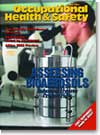
May 2003
Features
By Bob Henderson
OSHA's 29 CFR 1910.146, "Permit Required Confined Spaces," contains the requirements for practices and procedures to protect employees in general industry from the hazards of entry into permit-required confined spaces.
By Raymond H. Johnson Jr., CHP, PE, RSO
OCCUPATIONAL health and safety professionals may be well trained to deal with risks in the workplace, but are we prepared to deal with risks that may confront our own families?
By Robert Thomson
THE first in what appears to be a long stream of international machine safety standards was adopted recently by the United States. This standard (IEC-61496, parts 1 & 2) is a product standard for Electro Sensitive Protective Equipment, adopted as ANSI/UL 61496 parts 1 & 2.
By Hugh Hoagland, Bruce Sannar, Kent Givens, John Winn, Luciana Galo
It is commonly thought that low-voltage electrical arc accidents are harmless "poofs" as long as there is no electrical contact, and often this is true. The problem with low-voltage accidents is that the great majority are without consequence.
By Mike Avery
FOR most companies, including the majority of manufacturing firms, worker safety is a genuine priority. But when OSHA comes for a visit, safety personnel and management can feel their throats tightening and their heads pounding.
By Brian Shockley, QSSP
THE process of selecting appropriate respiratory protection can be as important and difficult as the decision about whether respiratory protection is needed in the first place. While the selection process can be complex and time consuming, the consequences of improper selection of respiratory protection equipment can be devastating.
By Steve Ferree
REDUCING air pollution emissions from vehicles in urban areas, combined with the desire to reduce dependence upon imported oil, resulted in several new regulations by federal, state, and local regulatory agencies in the 1990s.
By OH&S Staff
Editor's note: ZOLL Medical Corp., a producer of defibrillators and pacing devices for hospital physicians, nurses, and emergency medical technicians, introduced its first automated external defibrillator (AED) for public safety professionals and lay responders last year.
By Judie Smithers
SOME safety equipment blends into the background until it is urgently needed. The only people who probably pay close attention to emergency eyewash and shower equipment are those who inspect it. Even these inspectors may not have done any recent re-evaluations to determine whether the equipment is adequate for your current needs.
By Robert A. Ernst
WE all enjoy being outside when the weather is pleasant. And after a long winter, warming temperatures and sunny conditions lure our employees out of doors for work-related tasks, at-home yard work, or just for recreation. This creates some unique problems for those responsible for safeguarding the health and safety of workers.
By David C. Breeding, CSP
INDOOR air quality (IAQ) typically refers to the quality of air inside buildings where people work or live. Indoor air quality issues and specific building-related health concerns may result from a complex combination of physical, chemical, biological, ergonomic, and behavioral risk factors.
Departments
By Jerry Laws
AT first, it's hard to believe a simple red marker light presents a significant fire risk. More than 80 fires documented since July 2001 prove it, however. What is harder to believe is why these loading dock fires are a recent phenomenon: because enforcement of a U.S./Canadian safety regulation enacted in 1968 finally began four years ago.
By Valerie Weadock
LATE last year, two armed robbers stormed a Miami pizza shop, demanding cash and then fatally shooting an employee. The incident hit close enough to home for Steven Erekson, a 16-year old who works at a shop in the same chain less than 60 miles north of Miami, to take notice--but not close enough to make him worry or take any long-term related action.
By Larry Hansen, CSP, ARM
DOES this sound familiar? It's a scenario repeated in organizations year after year . . . the dreaded annual planning process! It starts at or about the end of the third quarter--Sept. 30, give or take a week. The CEO returns from the annual "Performance Improvement Strategy Session" with the board of directors and calls a Monday morning staff meeting.